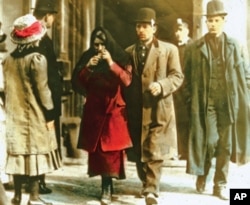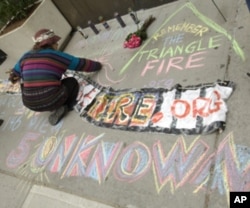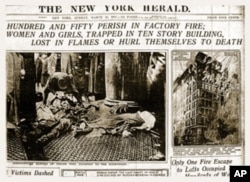March 25 is the 100th anniversary of New York’s Triangle Shirtwaist Factory fire, which left nearly 150 garment workers dead. Most of them were Jewish and Italian immigrant women and teenage girls who died from burns or jumped from windows to escape the blaze on the upper floors of the 10-story factory building.
The disaster led to workplace safety laws and the growth of powerful labor unions, such the International Ladies Garment Workers Union. The incident continues to inspire art, poetry, music and drama.
Today, three small plaques outside a building in Manhattan's Greenwich Village are the only visible reminders of the Triangle Shirtwaist Factory fire. The building now contains New York University classrooms and a library.
However, next door at the Grey Art Gallery, a multimedia exhibit called "Art/Memory/Place" makes the fire and the outrage that followed far more tangible. For example, a political cartoon published two days after the event shows a triangle with a charred female corpse in one corner, a death figure in another, and a greedy, uncaring factory boss in a third.
A photo of an epic 1930s mural (above) shows a column of poor immigrants, a dead worker and other sorrowful images beneath a black plume of smoke from the Triangle fire, while another panel depicts a worker’s paradise of clean factories, robust health and leisure - all thanks to organized labor.
For Lucy Oakley, programs director at the gallery, commemorating the Triangle fire has been a personal odyssey as well as a professional challenge. She remembers being deeply moved at the recent premiere of a documentary on the fire where she watched college students in period costume read the names of the young women and girls who died.
"Seeing them, you realized how incredibly young and in the flower of their lives those young workers were and how unbelievably tragic it was for their families and their whole communities to lose them at that age," says Oakley, adding that the fire also devastated communities throughout New York City. “As was demonstrated when 400,000 people came out for the funeral procession for the victims.”
Contemporary art in many media, including painting, music, and street theater also recalls the tragedy. Actress Lulo Lolo created a one-act play in which she re-imagines the words of reporter William Gunn Shepherd, who witnessed the blaze.
"The top three floors are ablaze. Those poor factory girls, they are hanging out the windows, they are hanging by their fingertips. They’re screaming. It’s a red furnace up there. They’re going to jump. We’re trying to get them to stop…"
Artist-activist Ruth Sergel founded the Remember the Triangle Fire Coalition, an umbrella group of nearly 250 organizations. She also created The Chalk Project, where volunteers go to the buildings where victims of the fire once lived and write a memorial to them in chalk on the sidewalk.
"I think once you’ve chalked somebody, you feel a certain sense of personal responsibility for them. You can never pass that building again without remembering that that’s where that particular individual lived," says Chalk. "You start to create and understand this whole other world that used to exist, which was cut off. These people were cut off at an extremely young age."
One teenage girl on school field trip to site of the Triangle fire with her classmates saw a chalk triangle for a 14-year-old victim who once lived across the street from her.
"And it really touched me because of the fact that a girl close to my age died," she says. "I can still feel her pain because she lost her whole life."
The Internet plays a key role in the commemorations. Perhaps the most ambitious online project has been Remember the Triangle Fire’s Open Archive.
Sergel says it welcomes posts in four areas: people, politics and activism, cultural response, and memorial.
"We have family members of both victims and survivors of the fire who are submitting photographs, memories of their family members. We also have a phenomenal treasure trove from Our Lady of Pompeii [church]; they lost 18 Italian-American victims in the fire. People are also contributing what they’ve written about the fire, paintings, children’s drawings. Every day it’s growing ."
The open archive also features poetry, including "Shirt," written and read by former U.S. Poet Laureate Robert Pinsky:
At the Triangle Factory in nineteen-eleven.
One hundred and forty-six died in the flames
On the ninth floor, no hydrants, no fire escapes-
The witness in a building across the street
Who watched how a young man helped a girl to step
Up to the windowsill, then held her out
Away from the masonry wall and let her drop.
And then another. As if he were helping them up
To enter a streetcar, and not eternity.
A third before he dropped her put her arms
Around his neck and kissed him. Then he held
Her into space, and dropped her. Almost at once
He stepped up to the sill himself, his jacket flared
And fluttered up from his shirt as he came down,
Air filling up the legs of his gray trousers-
Like Hart Crane's Bedlamite, "shrill shirt ballooning..."
Some artists believe that art and activism belong in separate spheres, but Sergel, an advocate for workers rights, believes art is a critical part of activism.
"It's the artists that make it possible for us to imagine a different world and not to be so pushed down so far that we can’t even think that it could be different. But the reality is it can be different."
Watch Peter Fedynsky Video story on the Triangle Fire:













